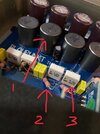Hello all, I am new here and not good with electronics and have been trying to identify the three components with the numbered red arrows (1,2&3) as well as their values.
1) ? (It says 998AMF-101 10506)
2) Through hole resistor 22R 1W 5%
3) ?
Please correct me if I am wrong and appreciate your guidance with number 1 & 3. Hope to get a reply.
Thank you!
Dion
1) ? (It says 998AMF-101 10506)
2) Through hole resistor 22R 1W 5%
3) ?
Please correct me if I am wrong and appreciate your guidance with number 1 & 3. Hope to get a reply.
Thank you!
Dion


